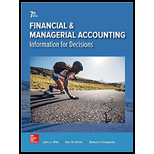
Concept explainers
Asset:
It refers to all valuable items that a company owns or items that generate some income to the company whether tangible or intangible. The more assets a company owns, the stable its financial position would be.
Accounting rule for assets is,
- Increase in assets is always debited
- Decrease in assets is always credited.
Liability: It refers to all items that have some monetary value in market and that company owes from others. The liability is much important for a company for financial support.
Accounting rule for liabilities is,
- Increase in liabilities is always credited.
- Decrease in assets is always credited.
Equity: It refers to the contribution that an owner makes to the company. The more equity the company has, the more profitable the company would be.
Accounting rule for equity is,
- Increase in Equity is always credited.
- Decrease in equity is always debited.
To classify: Items into asset (A) account, liability (L) account and equity (EQ) account.
Want to see the full answer?
Check out a sample textbook solution
Chapter 2 Solutions
GEN COMBO FINANCIAL AND MANAGERIAL ACCOUNTING; CONNECT ACCESS CARD
- Melford Industries sells a product to a wholesaler for $52. The wholesaler applies a 30% markup based on selling price when selling to a retailer. The retailer then applies a 40% markup based on selling price to determine the final price to the consumer. What is the final selling price to the consumer? Answerarrow_forwardI need help with this general accounting problem using proper accounting guidelines.arrow_forwardIf sales revenue is $220 million and accounts receivable decreased by $30 million, the amount of cash received from customers: a. was $150 million. b. was $125 million. c. depends on the mix of cash sales and credit sales. d. was $250 million.arrow_forward
- Please provide the solution to this financial accounting question with accurate financial calculations.arrow_forwardPlease explain this financial accounting problem by applying valid financial principles.arrow_forwardHenry is an all-equity firm that has 63,500 shares of stock outstanding at a market price of $22.80 per share. The firm is considering a capital structure with 45% debt at a rate of 6% and use the proceeds to repurchase shares. Determine the shares outstanding once the debt is issued.arrow_forward

 AccountingAccountingISBN:9781337272094Author:WARREN, Carl S., Reeve, James M., Duchac, Jonathan E.Publisher:Cengage Learning,
AccountingAccountingISBN:9781337272094Author:WARREN, Carl S., Reeve, James M., Duchac, Jonathan E.Publisher:Cengage Learning, Accounting Information SystemsAccountingISBN:9781337619202Author:Hall, James A.Publisher:Cengage Learning,
Accounting Information SystemsAccountingISBN:9781337619202Author:Hall, James A.Publisher:Cengage Learning, Horngren's Cost Accounting: A Managerial Emphasis...AccountingISBN:9780134475585Author:Srikant M. Datar, Madhav V. RajanPublisher:PEARSON
Horngren's Cost Accounting: A Managerial Emphasis...AccountingISBN:9780134475585Author:Srikant M. Datar, Madhav V. RajanPublisher:PEARSON Intermediate AccountingAccountingISBN:9781259722660Author:J. David Spiceland, Mark W. Nelson, Wayne M ThomasPublisher:McGraw-Hill Education
Intermediate AccountingAccountingISBN:9781259722660Author:J. David Spiceland, Mark W. Nelson, Wayne M ThomasPublisher:McGraw-Hill Education Financial and Managerial AccountingAccountingISBN:9781259726705Author:John J Wild, Ken W. Shaw, Barbara Chiappetta Fundamental Accounting PrinciplesPublisher:McGraw-Hill Education
Financial and Managerial AccountingAccountingISBN:9781259726705Author:John J Wild, Ken W. Shaw, Barbara Chiappetta Fundamental Accounting PrinciplesPublisher:McGraw-Hill Education





